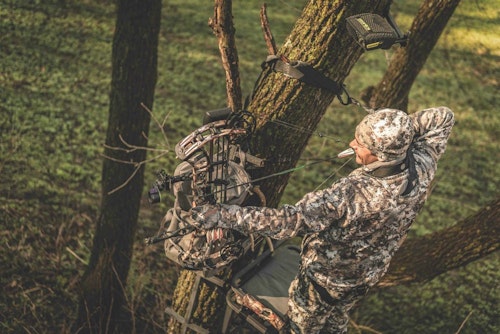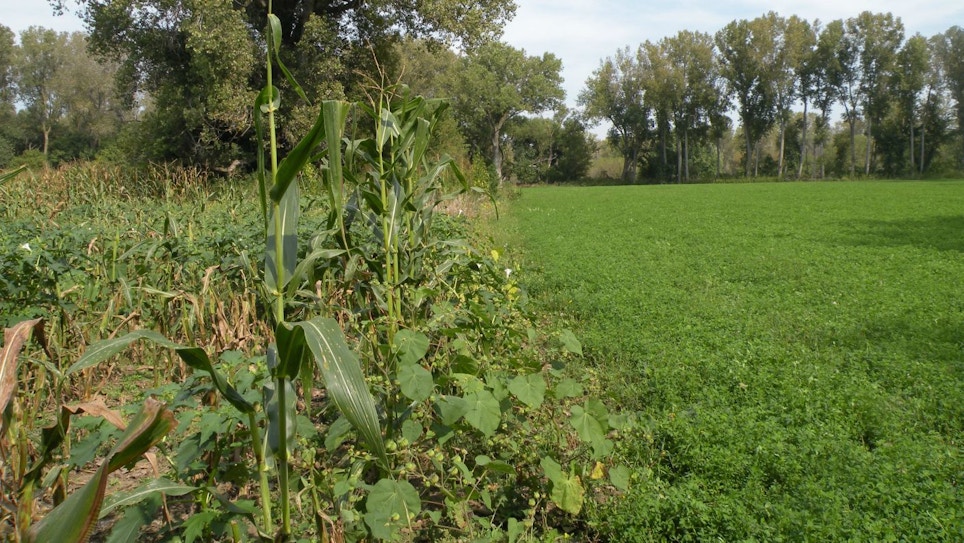I intentionally hunted the stand on the wrong wind direction — a risky maneuver, no doubt — because it was a traveling bowhunt, and because a better wind wasn’t in the coming week’s forecast. In other words, I had nothing to lose. With temps soaring to a sizzling 85 degrees that opening day, sweat poured from my face as I carefully approached the stand.
At the stand, I was greeted by swarms of itch-inflicting insects. My Thermacell quickly fixed the problem. Finally settled in, liberal showers of scent-eliminating spray dowsed any odors that had formed on me. I repeated as necessary. Gosh, it was hot!
A fawn was the sole deer to show until the final 5 minutes of legal shooting light. That’s when footfalls in the creek behind my stand alerted me. I felt certain a buck was approaching my well-placed stand, which hung 50 yards inside the timber off a small standing cornfield. I raised my binocular and confirmed the whitetail was a shooter, public land buck.
He paused and was facing me, obviously catching hints of my foreign odor. He spun to leave, so I instinctively mouth-grunted as a last resort. It worked. He stopped broadside in my 30-yard shooting lane. My pin hovered just behind his shoulder as I touched off the release. It was obviously a hit, and after he plunged through the creek, all commotion ceased.
I met my brother out by the road to discuss the events. Although I hadn’t seen my arrow impact, I felt extremely positive about the shot. We agreed it was best to track immediately given the hot temperatures. Off we went.
Soon, we found my blood-soaked arrow and took up the trail leading into the dense Nebraska understory. It ended 60 yards later with a beautiful September prize. My handsome Nebraska buck was a 135-incher with lots of gnarly character and a couple small chunks of velvet still clad to his antler bases. I was pleased with my opening-day trophy.
If opening-week success sounds appealing to you, consider the following four insights.
1. Identify Prime Food and Water Sources
Most successful early season whitetail strategies are crafted around two indispensable components: food and water.
Whitetail deer are habitual creatures. With the rut and then winter coming, they must gorge daily all summer and into early fall to fatten up for the trials that loom in their future. Take a late-afternoon summer spin on country backroads, and you’ll likely see whitetails munching in fields. It’s what they do.
When you’re crafting an opening-day game plan around a food source, it’s important to know which one bachelor groups of bucks are using daily. In agricultural areas, it’s as easy as sitting several hundred yards from a field with a binocular and spotting scope. This is the least-invasive scouting strategy, and it proves very effective for many bowhunters annually. Since crops rotate, a field that was dynamite last year could be virtually dead this year, and the only way to know is to log hours behind glass in the late afternoons.
Now, if it’s a more secluded food source like an oak flat or cluster of fruit-bearing trees, you have a couple viable options. First, you can carefully walk the area — spray down with a scent eliminator and go in on the right wind — and determine if acorns are falling and if deer are feeding there. Secondly, you can slip in and hang a cellular-capable trail camera, which will provide constant feedback as to deer activity in that immediate area, helping you craft a high-percentage opening-week strategy.
Water is the next vital component to a whitetail’s survival, especially in warmer, more arid regions of their range. Most expert agree that mature bucks typically drink 3 to 5 quarts of water per day. Like you and me, they drink to live. If a waterhole or equivalent is between a bedding area and food source, that’s where I’d place my bet on opening afternoon given warm conditions.
2. Place Stands to Capitalize on Tendencies
When you observe fields, you’ll often find that bucks enter in a relatively similar location every evening. But, remember we’re trying to orchestrate a 20- to 30-yard bow shot. Hunting directly over a field can cause problems with exiting the stand following unsuccessful hunts. Plus, deer can easily feed all evening just out of bow range. The more times you miss the mark, the more intrusion you introduce to the area, and the quicker bucks will sense the pressure and shift patterns.
For those reasons, treestands, when possible, are best hung along the route bucks are using to enter a given field. Often, it’s a pocket of trees 50 to 100 yards off the field where bucks loiter until just before dark. It provides you an easier out if you’re unsuccessful, and you’ll often be better positioned for a 30-yard-and-in bow shot. Further, you’ll more likely capitalize on a mature buck’s daytime movements; most enter fields at or after dusk.
Now, if you’re targeting a mature buck near secluded forest food sources, it’s usually most practical to hang right over the acorns or apple trees since bucks are more likely to appear well before shooting light fades due to the forest security. However, you must understand they’re liable to bed close by. This could present possible stand-access problems, but if you’re extremely stealthy, you can pull it off.
3. Don’t Forget the Wind
I forsook this advice during the out-of-state Nebraska hunt I mentioned in my opening paragraphs, but I suggest hunting stands only when the wind direction is perfect. I made an exception on that hunt because I wasn’t going to get a better wind during my only week to hunt, and the risk proved worth the reward.
If you’re hunting on private land and have all season, wait for the optimal wind direction. If you must hunt a questionable wind, I suggest using an Ozonics unit. I’ve used them with outstanding results during elk, whitetail and mule deer hunts without spooking animals directly downwind.

4. Standing Corn Is Not Your Friend
Alfalfa and soybean fields can be money during opening week, and deer rarely bed in them (though this varies by region). Standing cornfields are another story because they can offer food and security in one location.
I’ve encountered this dilemma during multiple hunts, and it makes hunting difficult. Why? Deer need not leave standing cornfields except for water, so that is often your best chance to capitalize.
Final Thoughts
I love opening week because I love experiencing deer doing what deer do. In other words, they’ve been pressured very little or not at all, and well-laid bowhunting plans stand a high-percentage chance of producing a trophy buck. I love the rut, too, but most bucks, although more susceptible during daylight, can be quite unpredictable. That’s why it’s crucial to take advantage of the early season tendencies of the largest bucks in the area.
Will you be in a stand during opening week this fall?






